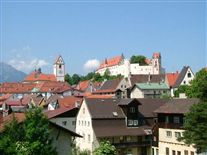Fuessen1.jpg
We visit Fussen after Easter Services - Click 'Details' for more information
History and geography:
Füssen is a town in Bavaria, Germany, in the district of Ostallgäu situated 5 kilometres (3 miles) from the Austrian border. It is located on the banks of the Lech river. The River Lech flows into the Forggensee. Füssen's coat of arms shows a triskelion (three legs).
It had been a settlement in Roman times on the Via Claudia Augusta, a road that leads southwards to northern Italy and northwards to the former regional capital of the Roman province called Raetia, the capital of which was Augusta Vindelicum today's Augsburg. The original name of Füssen was "Foetes", or "Foetibus" (inflected), which derives from Latin "Fauces", meaning "gorge", probably referring to the Lech gorge. In Late Antiquity Füssen was the home of a part of the Legio III Italica, which was stationed there to guard the important trade route over the Alps.
The "Hohes Schloss" (High Castle), the former summer residence of the prince bishops of Augsburg and one of Bavaria's largest and best preserved late Gothic castle complexes, is Füssen's landmark. Today the castle houses a branch gallery of the Bavarian State Collections of Paintings, which focuses on late Gothic and Renaissance works of art. Below the Hohes Schloss is the Baroque complex of the former Benedictine monastery of St. Mang, whose history goes back to the 9th century.
Füssen is the highest town in Bavaria (808 m above sea level). The famous castles of Neuschwanstein and Hohenschwangau are located near the town; travellers by rail change on to buses 73/78 at Füssen railway station. Richard Wagner the famous German composer, used to come to Füssen by railway when he visited King Ludwig II. The town is also familiar to travellers as the terminus of the Romantic road. Steve McQueen's motorcycle stunts and many other scenes in The Great Escape were filmed in and around the town. During World War II, a subcamp of the Dachau concentration camp was located in the town.[2]
The Forggensee is a man-made lake which was built to prevent flooding. It is the catchment area for all the melting snow in the spring. After the middle of October the lake is drained ready for the next spring melt.
Füssen has Saint Mang (Magnus of Füssen) as its Patron Saint. His original burial place was in the small chapel he built. His bones were transferred to the crypt of the church being built in 850. Around the year 1100 all his bones disappeared. The burial place in the crypt of the St Mang Basilica can be seen today, although the only bone of St Mang is a relic which can be found above the main altar in a glass cross. The cross also contains his staff, breast cross and chalice. St Mang's Feast Day is 6 September. On this day Holy Mass is celebrated, then all proceed by torchlight through the old part of the city. During the week of the Saint's Feast a special 'Magnus Wine' is sold. Only 500 bottles are produced. The 2009 vintage was produced in South Tyrol and is described as "Good bouquet, light and fruity". Also it has a label change showing the Basilica of St Mang with a photo of a Statue of St Mang super-imposed on it.
The oldest fresco in the whole of Germany can be found in the crypt of St Mang's Basilica. It dates back to about the year 980.
Another son of Füssen has been raised to the title of Blessed by the Roman Catholic Church. Francis Xavier Seelos was born 11 January 1819 in Füssen. His father was the sacristan at St Mang's Basilica. He became a priest of the Congregation of the Most Holy Redeemer. Seelos died in New Orleans, USA on 4 October 1867. He was made a Blessed on 9 April 2000 by Pope John Paul II. The Shrine and Relics of the Blessed Seelos can also be found in the Basilica. His Feast Day is 5 October.
